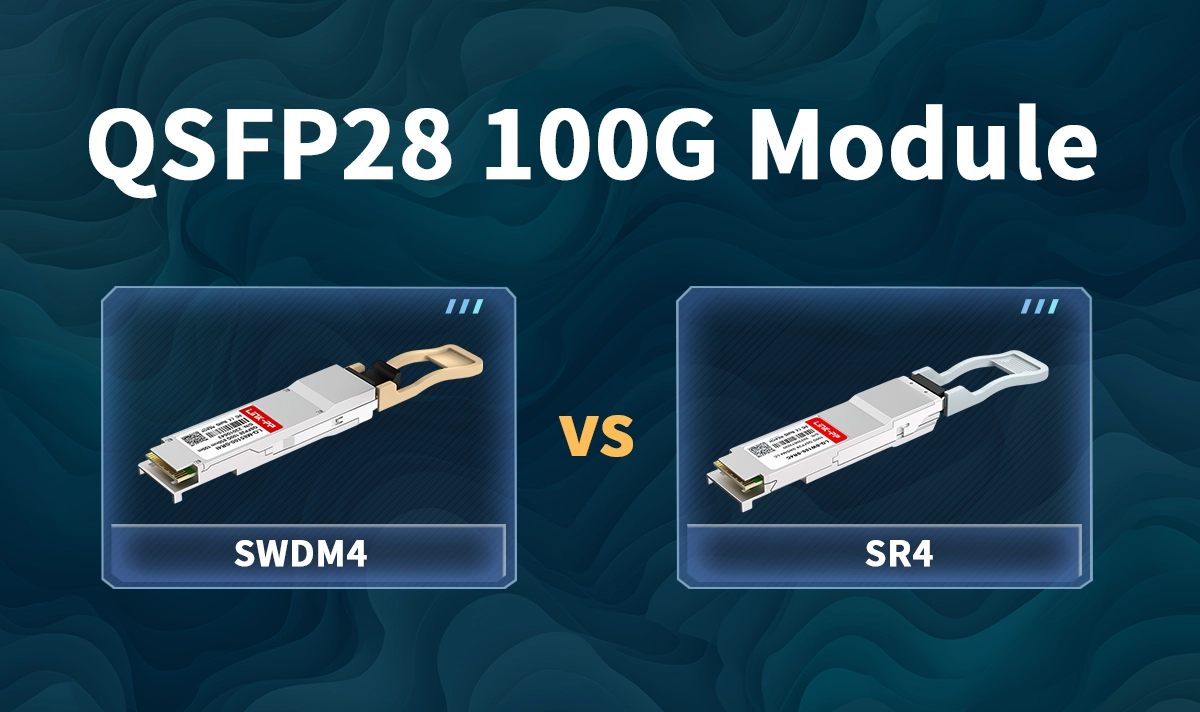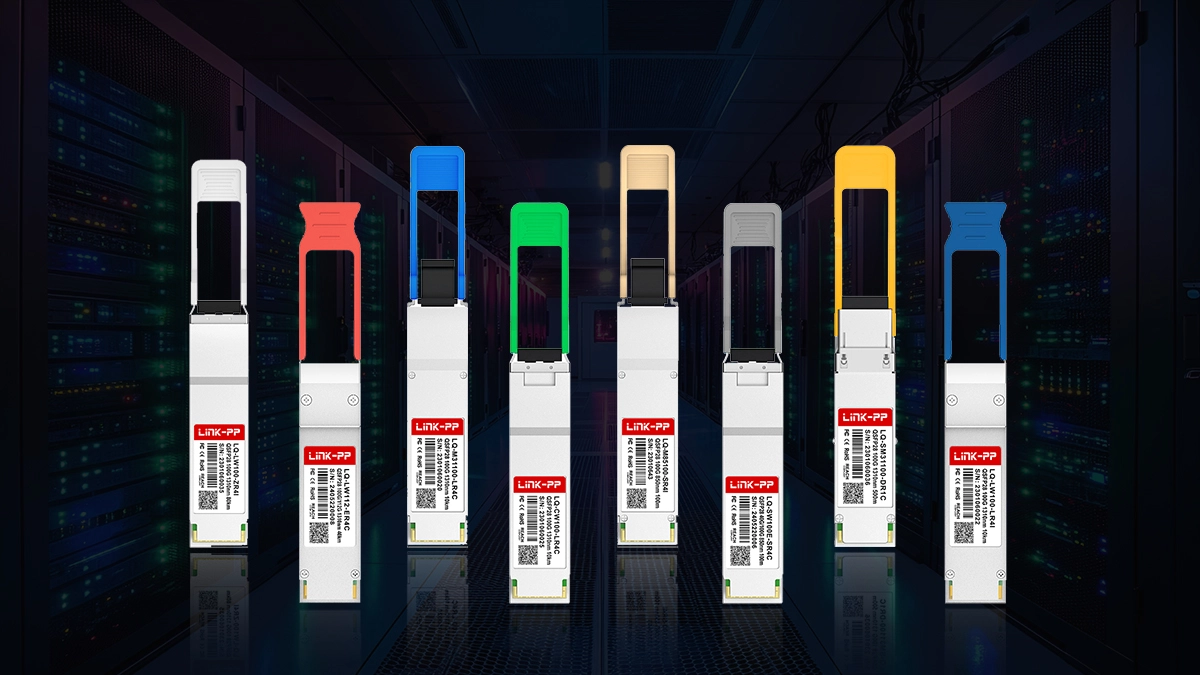
In the high-stakes world of data center architecture, upgrading to 100G Ethernet is no longer a question of "if" but "how." Choosing the right optical transceiver is a critical decision that impacts your network's performance, scalability, and total cost of ownership (TCO). Two of the most popular contenders for short-reach 100G applications are the QSFP28 100G SR4 and the QSFP28 100G SWDM4.
At first glance, they achieve the same goal, but their underlying technology leads to vastly different real-world implications. This guide will demystify these two technologies, providing a clear, side-by-side comparison to help you, the network professional, make an informed decision. We'll also highlight how LINK-PP's reliable and high-performance optics can be the optimal solution for your infrastructure.
📝 Breaking Down the Basics: SR4 vs. SWDM4
First, let's understand what these acronyms mean and the core technology behind each standard.
🤔 What is QSFP28 100G SR4?
Technology: Parallel Fiber (4 lanes)
How it works: The 100G SR4 (Short Range 4) module uses four independent transmit and four independent receive channels. It requires 8 fibers (4 for Tx, 4 for Rx) in a 12-fiber MPO/MTP® connector. It operates on a wavelength of ~850nm across all lanes.
Key Requirement: It mandates OM3 or OM4 multimode fiber (MMF) cabling to achieve its standard reach of 70m and 100m, respectively.
🤔 What is QSFP28 100G SWDM4?
Technology: Wavelength Division Multiplexing (WDM) over Dual Fiber
How it works: The SWDM4 (Shortwave Wavelength Division Multiplexing 4) module is more sophisticated. It multiplexes four different "shortwave" wavelengths (850nm, 880nm, 910nm, 940nm) onto a single pair of fibers (one for Tx, one for Rx), using standard LC duplex connectors.
Key Requirement: It is also designed for use with OM3, OM4, or the newer OM5 wideband multimode fiber.
📝 Head-to-Head Comparison: SWDM4 vs. SR4
The fundamental difference in technology creates a ripple effect across several key decision-making factors. Let's break it down in a clear table.
Feature | QSFP28 100G SR4 | QSFP28 100G SWDM4 | Winner? |
|---|---|---|---|
Technology | Parallel Optics (4 lanes) | WDM (Wavelength Division Multiplexing) | - |
Data Rate | 100Gbps (4x25G) | 100Gbps (4x25G) | Draw |
Reach on OM4 | 100 meters | 150 meters | SWDM4 🥇 |
Fiber Count | 8 fibers (MPO-12 connector) | 2 fibers (LC duplex connector) | SWDM4 🥇 |
Connector Type | MPO/MTP® | Standard LC Duplex | SWDM4 🥇 |
Cabling | Requires new MMF MPO harnesses | Leverages existing LC duplex MMF patch cables | SWDM4 🥇 |
Fiber Type | OM3, OM4 | OM3, OM4, OM5 (optimal) | SWDM4 🥇 |
Power Consumption | ~3.5W | ~3.5W | Draw |
Initial Cost | Generally Lower | Generally Higher | SR4 🥇 |
📝 When to Choose Which Transceiver?
Your choice depends entirely on your data center's current infrastructure and future plans.
Choose QSFP28 100G SR4 if:
You are building a new, greenfield data center and can install new MPO-based OM4 trunk cables.
Your link distances are under 100m and you have no need for extended reach.
Initial component cost is your primary driver, and you are less concerned about fiber density.
Choose QSFP28 100G SWDM4 if:
You are upgrading an existing data center with pre-installed 2-fiber LC duplex OM3/OM4 cabling. This is the killer feature of SWDM4, offering massive cost savings on cabling.
Fiber density is a major concern. SWDM4 uses 75% fewer fibers, allowing you to support more connections without exhausting your fiber patch panels.
You need distances beyond 100m on multimode fiber, up to 150m on OM4 and even further on OM5.
You are future-proofing with OM5 fiber. SWDM4 is designed to maximize the potential of OM5's wider bandwidth.
For those looking for a reliable and compatible SWDM4 module, the LINK-PP LQ-SW100-SR4C offers a perfect blend of performance and value, fully compliant with MSA standards and rigorously tested for interoperability.
📝 Conclusion and Final Recommendation
There is no single "best" choice—only the best choice for your specific scenario.
SR4 is the straightforward, cost-effective workhorse for new, short-reach deployments.
SWDM4 is the clever, fiber-saving innovator ideal for upgrades, maximizing density, and extending the life of your legacy multimode fiber plant.
For most enterprises looking to migrate to 100G without the prohibitive cost and hassle of a complete fiber re-cabling project, SWDM4 presents a compelling and ROI-positive solution.
🚀 Ready to Optimize Your 100G Migration?

Navigating the complexities of high-speed data center connectivity can be challenging. Whether you're leaning towards the robust simplicity of SR4 or the fiber-efficient brilliance of SWDM4, choosing a trusted supplier is paramount.
LINK-PP offers a comprehensive range of high-quality, compatible 100G QSFP28 transceivers, including both SR4 and SWDM4 models, all backed by a lifetime warranty and expert support.
📞 Contact our solutions experts today for a free consultation! Let us help you audit your current infrastructure and identify the most cost-effective and high-performance path to 100G. Browse our selection of [LINK-PP QSFP28-100G-SR4] and [LINK-PP QSFP28-100G-SWDM4] modules to find your perfect match.
📝 FAQ
What is the main difference between 100G SWDM4 and 100G SR4?
100G SWDM4 uses duplex multimode fiber with LC connectors. 100G SR4 uses ribbon multimode fiber with MPO-12 connectors. You should choose SWDM4 for upgrades and SR4 for new installations.
Which transceiver is better for upgrading existing data centers?
You should pick 100G SWDM4. It works with your current duplex multimode fiber and LC connectors. You do not need to change your cabling.
Can I use 100G SR4 in a data center with only duplex fiber?
No, you cannot. 100G SR4 requires ribbon multimode fiber and MPO-12 connectors. You need to install new cabling if you want to use SR4.
Which option offers longer transmission distance?
100G SWDM4: Up to 150 meters on OM4 fiber
100G SR4: Up to 100 meters on OM4 fiber
You get more reach with SWDM4.
How do costs compare between SWDM4 and SR4?
100G SR4 modules usually cost less per unit. SWDM4 may save you money on upgrades because you keep your existing fiber. Always check your current setup before deciding.




